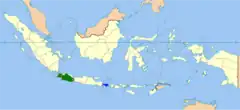Sundanese–Balinese relations
Sundanese–Balinese relations is the relationship between the people of Sundanese and Balinese that has existed since the rule of the Galuh Kingdom on the western island of Java. This relationship includes civilization, belief, culture, and others.
According to I Gusti Ngurah Sudiana, a Balinese cultural observer, Sundanese culture is the origin of the formation of Balinese culture. He also mentioned that Bali is only a small part of the great culture of Pasundan (another name for Sundanese) which is still guarded and cared for today. In another explanation, it is also stated that the majority of Balinese Hindus admit that they are a Lesser Sundanese people who are part of the Sundanese civilization.[1]
History
According to history, the Balinese Hindus originally came from the Galuh Kingdom which began during the heyday of Hinduism and Buddhism in the Nusantara (refers to present-day Maritime Southeast Asia), until later when Islamic influence from the Cirebon Sultanate entered the Galuh area. At this time, those who still wanted to embrace Hinduism or ancestral teachings then decided to leave their hometown in Galuh and go to the area around Mount Bromo in eastern of Java. While there, they were again pushed back by the spread of Islam from the Demak Sultanate. Then after that, they decided to go east and cross to the island of Bali, until they were assimilated by the population that had been there before.[1]
Languages
Based on classification by linguists, Sundanese and Balinese are included in the Malayo–Polynesian branch of the Austronesian family.[2] The similarities in the vocabulary of these two languages can be seen from the word gedang, different in Javanese which means "banana", in Sundanese and Balinese it has the same meaning, namely "papaya". To say "drink" in Sundanese is nginum, while in Balinese is inum.[3]
Palinggih
Ratu Bagus Sundawan is the name of one of palinggih in the Gambur Anglayang State Temple. This temple is located in Kubutambahan Village, Kubutambahan District, Buleleng Regency, Bali. Palinggih itself is a place to worship ancestors in Balinese beliefs.[4]
Background to the establishment of this palinggih is an expression of gratitude from a group of traders whose ship sank on Kutabanding Beach, Kubutambahan. The group of traders is said to be Sundanese adherents of Christianity who came from the west of the island of Bali. According to folklore, Ratu Bagus Sundawan himself was a handsome man.[4]
See also
References
- "Sejarah Peradaban Sunda dan Bali, Umat Hindu Bali Adalah Masyarakat Sunda Kecil". www.jurnalflores.co.id (in Indonesian). 3 August 2023. Retrieved 5 October 2023.
- Adelaar, K. Alexander (2005). "The Austronesian languages of Asia and Madagascar: a historical perspective". In Adelaar, K. Alexander; Himmelmann, Nikolaus (eds.). The Austronesian languages of Asia and Madagascar. London: Routledge. pp. 1–42.
- "Sulinggih Bali Saba Banten 1: Persamaan Budaya Sunda Banten Dengan Bali". bingar.id (in Indonesian). 10 July 2023. Retrieved 5 October 2023.
- "Palinggih Ratu Bagus Sundawan Berkaitan dengan Umat Kristen". baliexpress.jawapos.com (in Indonesian). 17 January 2023. Retrieved 5 October 2023.
